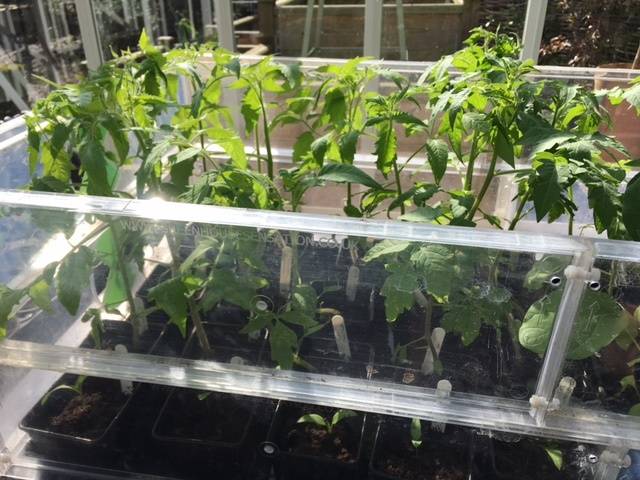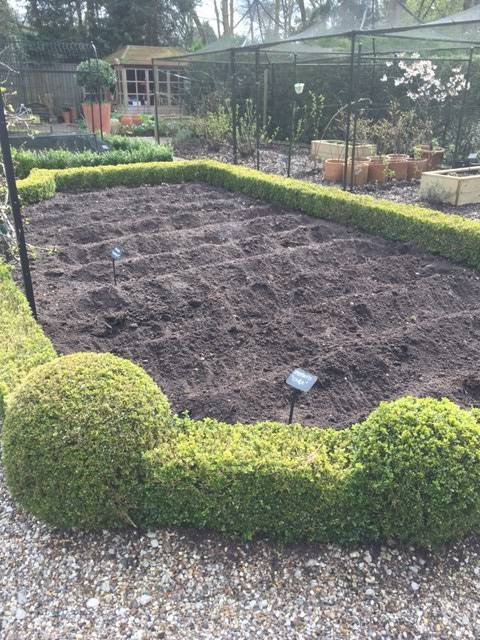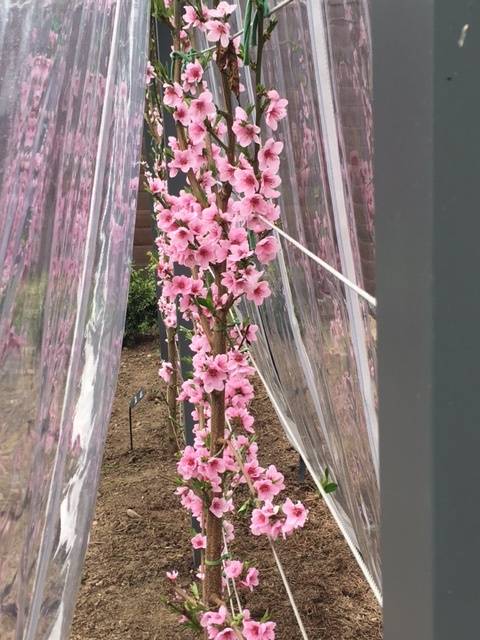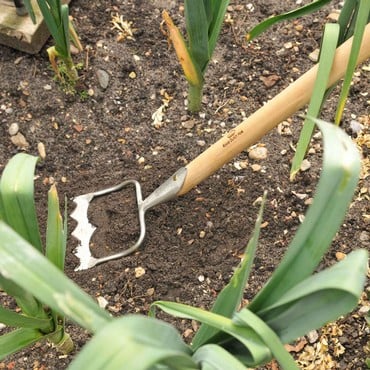 The garden has undertaken a dramatic transformation this month; from the bare brown soil of winter to the sea of green that the warm spring sunshine brings. The weather has been very mild this month and plants all around the garden are putting on lots of new growth.
The garden has undertaken a dramatic transformation this month; from the bare brown soil of winter to the sea of green that the warm spring sunshine brings. The weather has been very mild this month and plants all around the garden are putting on lots of new growth.
Nowhere is the new season more evident than in the greenhouse. It was busy at the beginning of the month but as March draws to a close it is crammed with fast growing plants and seedlings jostling for place on the staging. We now have two propagators working – a heated one to start off our crops and an unheated one to move tender crops such as tomatoes aubergines and peppers into once they have become bigger. As soon as crops have been ready, we have been moving them into the cold frame to make room for more seed sowing. After a couple of weeks hardening off to the cool night time temperatures, crops such as onion and shallots have been planted outside into their final growing places.
The greenhouse temperature is varying dramatically at the moment as the nights are still very cold, but on sunny days the temperature inside has been soaring. Our autovents on the windows have been activated on recent days, providing valuable ventilation when it is needed. We’ve also been opening the door on warm days to allow air to circulate, taking care to close it again quickly when the temperature drops.
One of my very favourite gardening jobs is pricking out and potting on seedlings and young plants. It’s a real treat for me, on a sunny day with the radio on, to spend an hour or two at the potting bench tending to our new crops. It’s therapeutic and very relaxing. Lucky for me I have been spending quite a bit of time at the potting bench this month and it shows no sign of slowing down just yet! The new sowings we have made in March are cucumbers, courgettes, peppers, squash, sweetcorn, salads, rocket, basil, tarragon, kohl rabi and kale.
Outside in the main Kitchen Garden we finished digging over our beds early in the month and they are already filling up. In the middle of the month we planted our early seed potatoes into the ground, as well as starting some off in a pot in the greenhouse to force an early crop. As I write this, we have just planted out our maincrops too.
Other plantings include our broad bean plants. We made a sowing of these in the autumn and always follow it up with a further sowing in the spring. This year the winter plants have not fared well, which is hardly surprising given the cold winter we have had. We have  lost a few plants and a couple are looking decidedly unhealthy. In contrast, the spring sown plants were flourishing in the cold frame and have now been planted into the ground to fill the gaps. Initially the plants will be protected with netting to stop the pigeons from snacking on them. This will be removed when they begin flowering to allow the pollinating insects to do their work.
lost a few plants and a couple are looking decidedly unhealthy. In contrast, the spring sown plants were flourishing in the cold frame and have now been planted into the ground to fill the gaps. Initially the plants will be protected with netting to stop the pigeons from snacking on them. This will be removed when they begin flowering to allow the pollinating insects to do their work.
Unfortunately, our crops are not the only thing to be enjoying the current warm conditions; the weeds have also been thriving! The kitchen garden is almost weed-free following the digging of the beds, however in the ornamental gardens they have been colonising the bare soil between the perennials. It won’t be long before the perennials fill out and cover the ground, smothering any weeds, but in the mean-time we have been out with the hoes and hand forks teasing them out of the ground before they set seed. It’s a delicate job as the tulips are a few inches tall and we have had to be careful not to damage any before they flower.
Our first harvest of the new season has been forced rhubarb. We have been keeping a close eye on the two plants currently covered by rhubarb forcers and they are literally growing while we watch! One morning I arrived at the garden to find the lid of one of the forcers slightly raised. The first crop of forced rhubarb always tastes amazing and I indulged in raw sticks of it dipped in sugar. Pure heaven!
March has been very dry in our part of the world and we are missing the usual spring rainfall. We have already had to do a lot of watering for this time of the year, especially concentrating on pot grown plants that have dried out quickly in the easterly winds. Spring rain is also very important to fruit bushes and trees, as well as garlic and asparagus so it’s essential to keep them well watered. Hopefully we will get some decent rainfall very soon, but in the meantime we are enjoying strolling with the watering can in the sunshine.
The soil temperatures have been warm enough for our first application of nemslug for a couple of weeks now, however the recent dry conditions have delayed this as the nematodes are best applied to wet soil, preferably on a rainy day. We haven’t had many of these of late, and there are none on the immediate forecast. The nematodes can sit in the fridge until rain comes. Luckily, the slugs and snails don’t like dry soil either!
the fridge until rain comes. Luckily, the slugs and snails don’t like dry soil either!
One of the highlights of the month has been the blossom on our peach trees. Planted 18 months ago, they have become well established and are now a blaze of pink blossom; causing much excitement in the garden. They are still covered to prevent peach leaf curl. We have been out with a soft paintbrush to give the bees a helping hand with the pollination, but the bees have also been out in force in the warm sunshine. The tree covers are open ended which still allows the bees to get access to the flowers. We are hoping for a bumper crop this year
Here are some of the jobs we’ve got planned for April in Stephanie’s Kitchen Garden:
- Sow runner beans and climbing French beans.
- Apply nemaslug to the soil.
- Pot on seedlings.
- Plant out brassicas such as sprouts, kale and broccoli.
- Keep watering while conditions are dry.
We’re always here to offer help and support. Go to the Ask the Expert section on our website and email horticultural advisor Jo Blackwell with your queries and she’ll do her best to help.
We’re busy tweeting about all things Harrod Horticultural – what we’re doing, special offers, gardening tips and advice and you can always use Twitter or Facebook to get in touch with us as well. With our webteam manning the Tweet desks and Facebook site, you can be sure you will get the best service we can offer.
Our 108 page catalogue is out now and packed full of gardening ideas and products to solve the problems every gardener faces, plus plenty more seasonal ideas for harvesting, storage and preserving.
XX

























